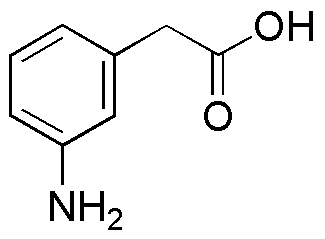3-Aminophenylacetic acid is widely utilized in research focused on:
- Pharmaceutical Development: This compound serves as a key intermediate in the synthesis of various pharmaceuticals, particularly in the development of analgesics and anti-inflammatory drugs, enhancing pain management options.
- Biochemical Research: It is used in biochemical assays to study enzyme activity and protein interactions, providing insights into metabolic pathways and disease mechanisms.
- Neuroscience Studies: The compound plays a role in neuropharmacology, helping researchers investigate its effects on neurotransmitter systems, which can lead to advancements in treatments for neurological disorders.
- Diagnostic Applications: It is utilized in the formulation of diagnostic agents, aiding in the detection of specific biomarkers in clinical settings, improving accuracy in disease diagnosis.
- Material Science: 3-Aminophenylacetic acid is explored in the development of polymers and coatings, offering enhanced properties such as increased adhesion and durability in various industrial applications.
General Information
Properties
Safety and Regulations
Applications
3-Aminophenylacetic acid is widely utilized in research focused on:
- Pharmaceutical Development: This compound serves as a key intermediate in the synthesis of various pharmaceuticals, particularly in the development of analgesics and anti-inflammatory drugs, enhancing pain management options.
- Biochemical Research: It is used in biochemical assays to study enzyme activity and protein interactions, providing insights into metabolic pathways and disease mechanisms.
- Neuroscience Studies: The compound plays a role in neuropharmacology, helping researchers investigate its effects on neurotransmitter systems, which can lead to advancements in treatments for neurological disorders.
- Diagnostic Applications: It is utilized in the formulation of diagnostic agents, aiding in the detection of specific biomarkers in clinical settings, improving accuracy in disease diagnosis.
- Material Science: 3-Aminophenylacetic acid is explored in the development of polymers and coatings, offering enhanced properties such as increased adhesion and durability in various industrial applications.
Documents
Safety Data Sheets (SDS)
The SDS provides comprehensive safety information on handling, storage, and disposal of the product.
Product Specification (PS)
The PS provides a comprehensive breakdown of the product’s properties, including chemical composition, physical state, purity, and storage requirements. It also details acceptable quality ranges and the product's intended applications.
Certificates of Analysis (COA)
Search for Certificates of Analysis (COA) by entering the products Lot Number. Lot and Batch Numbers can be found on a product’s label following the words ‘Lot’ or ‘Batch’.
*Catalog Number
*Lot Number
Certificates Of Origin (COO)
This COO confirms the country where the product was manufactured, and also details the materials and components used in it and whether it is derived from natural, synthetic, or other specific sources. This certificate may be required for customs, trade, and regulatory compliance.
*Catalog Number
*Lot Number
Safety Data Sheets (SDS)
The SDS provides comprehensive safety information on handling, storage, and disposal of the product.
DownloadProduct Specification (PS)
The PS provides a comprehensive breakdown of the product’s properties, including chemical composition, physical state, purity, and storage requirements. It also details acceptable quality ranges and the product's intended applications.
DownloadCertificates of Analysis (COA)
Search for Certificates of Analysis (COA) by entering the products Lot Number. Lot and Batch Numbers can be found on a product’s label following the words ‘Lot’ or ‘Batch’.
*Catalog Number
*Lot Number
Certificates Of Origin (COO)
This COO confirms the country where the product was manufactured, and also details the materials and components used in it and whether it is derived from natural, synthetic, or other specific sources. This certificate may be required for customs, trade, and regulatory compliance.


